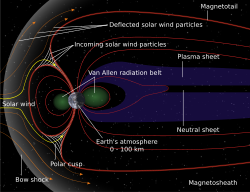Vacuum
A vacuum is a place where there is no matter, not even air. Sound cannot move in a vacuum. No place has a perfect vacuum, because a small number of particles remain, even in outer space.
A space where only some of the removing air is also called a vacuum. The space then has lower pressure, even though most of the air remains.
Common uses
- A vacuum cleaner works by pumping away some of the air. The air and dirt in a room rush into the vacuum left behind, where the dirt is caught by a filter.
- An automobile engine that burns fuel uses a vacuum to pull in air, which contains oxygen that allows the fuel to burn.
- An incandescent lightbulb has a vacuum inside so the hot filament doesn't burn up.
Industrial uses
Vacuum Media
Vacuum pump and bell jar for vacuum experiments, used in science education during the early 20th century, on display in the Schulhistorische Sammlung ('School Historical Museum'), Bremerhaven, Germany
Torricelli's mercury barometer produced one of the first sustained vacuums in a laboratory.
The Crookes tube, used to discover and study cathode rays, was an evolution of the Geissler tube.
A video of an experiment showing vacuum fluctuations (in the red ring) amplified by spontaneous parametric down-conversion.
Structure of the magnetosphere - is not a perfect vacuum, but a tenuous plasma awash with charged particles, free elements such as hydrogen, helium and oxygen, electromagnetic fields.
Light bulbs contain a partial vacuum, usually backfilled with argon, which protects the tungsten filament
This shallow water well pump reduces atmospheric air pressure inside the pump chamber. Atmospheric pressure extends down into the well, and forces water up the pipe into the pump to balance the reduced pressure. Above-ground pump chambers are only effective to a depth of approximately 9 meters due to the water column weight balancing the atmospheric pressure.
Deep wells have the pump chamber down in the well close to the water surface, or in the water. A "sucker rod" extends from the handle down the center of the pipe deep into the well to operate the plunger. The pump handle acts as a heavy counterweight against both the sucker rod weight and the weight of the water column standing on the upper plunger up to ground level.
A cutaway view of a turbomolecular pump, a momentum transfer pump used to achieve high vacuum
Vacuum is needed for some kinds of machines used for industrial production. Vacuum pumps are used to pump air out of a vacuum chamber. It is not possible to create 100% vacuum, but some vacuum pumps are able to create 99.9999% vacuum. This is called "hard vacuum". Most industrial purposes do not need hard vacuum.
Industrial vacuums are mainly used in:
- Food industry
- Electronics industry
- Packaging
- Manipulation
- Coating and degasing
Scientific experiments
Vacuum chambers are also used in many scientific experiments in laboratories. Some experiments in physics and chemistry need hard vacuum to keep any air or other gases from interfering with delicate surfaces or chemicals that can react.








